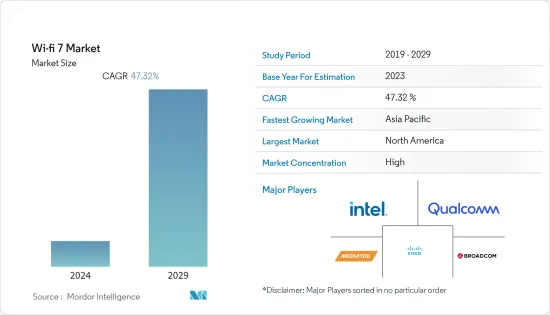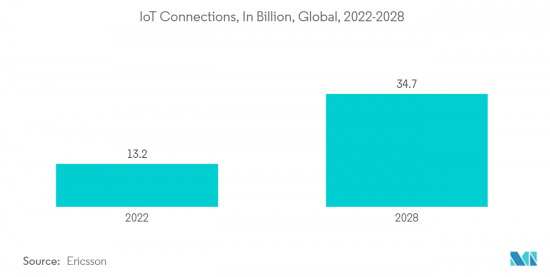PUBLISHER: Mordor Intelligence | PRODUCT CODE: 1408569

PUBLISHER: Mordor Intelligence | PRODUCT CODE: 1408569
Wi-fi 7 - Market Share Analysis, Industry Trends & Statistics, Growth Forecasts 2024 - 2029

The Wi-Fi 7 market market was valued at USD 875.21 million in the current year and is expected to reach USD 6073.23 million in the next five years, registering a CAGR of 47.32% over the forecast period.
Key Highlights
- Wi-Fi 7 is known as the IEEE standard 802.11be. It works with several different radio frequencies, including 2.4GHz, 5GHz, and 6GHz. It offers links at a maximum speed of 40,000 Mbit/s. The quality and resolution of video streaming are improved by 16 spatial streams and Multiple Input Multiple Output (MIMO) technology. Hybrid Automatic Repeat Request (HARQ), a feature of Wi-Fi 7, facilitates multiple link adaptation.
- The upcoming revision of the IEEE 802.11 standard, called IEEE 802.11be, is Extremely High Throughput (EHT). On top of 802.11ax, it will emphasize WLAN indoor and outdoor operating at pedestrian and stationary speeds in the 2.4, 5, and 6 GHz frequency bands. It is anticipated that the speeds will match Thunderbolt at 40 Gbps.
- The throughput needed for video distribution will continue to rise to tens of Gbps with the introduction of 4k/8k video. Online gaming, augmented reality (AR), virtual reality (VR), and other fresh, high-throughput, and low-latency video applications are also exploding. Supporting these applications over a wireless local area network (WLAN) is much beyond the capabilities of the latest WLAN standard, IEEE 802.11ax, because of the associated strict requirements.
- The IEEE 802.11 will publish a new amendment standard, IEEE 802.11be - Extremely High Throughput (EHT), often known as Wireless-Fidelity (Wi-Fi) 7, to satisfy these growing demands. A growing number of customers are engaging in e-commerce transactions, web browsing, mobile learning, and other online-related activities, driving the demand for faster internet access. As a result, the wireless router, frequently utilized in laptops, PCs, and tablets, has become essential for human existence. Wi-Fi routers are mostly responsible for the rising need among consumers to stay linked to dependable Internet and for enhancing Wi-Fi connections in numerous nations.
- Moreover, the increasing use of connected devices in healthcare, education, business, financial services, and other applications is one of the key drivers of the worldwide Wi-Fi 7 market. Additionally, the market growth is positively impacted by small and medium businesses adopting a bring your device policy. Further, during the projected period, a surge in government initiatives for smart city projects is anticipated to create lucrative opportunities for market expansion.
- As mobility restrictions were enforced to contain the spread of the coronavirus (COVID-19), more and more of the estimated 1.3 billion citizens of Organization for Economic Cooperation and Development (OECD) countries worked and studied from home. Critical international policy coordination was conducted online in fora, such as the G7 or G20. Along the entire Internet value chain, fixed and mobile broadband operators, content and cloud providers, and points where Internet networks connected to exchange traffic, called Internet exchange points (IXPs), experienced as much as 60% more Internet traffic than before the outbreak. These factors positively affected the demand for Wi-Fi 7 post-pandemic.
Wi-fi 7 Market Trends
Ongoing Smart City Projects Focused on Deployment of Outdoor Wi-Fi in Emerging Regions
- As smartphones have a combination of volume and heavy data usage across a wide variety of applications in both consumer and enterprise settings, the need for high bandwidth with flexibility is increasing. As technology evolves, market vendors have been getting the increased need for higher data rates, lower latency, and better network capacity, thus creating opportunities in advanced technologies such as Wi-Fi 7.
- In 2022, the International Telecommunication Union (ITU) estimated that 5.3 billion people, or 66% of the world's population, utilize the Internet. This marks a 24% growth from 2019, with an expected 1.1 billion people joining the Internet throughout that time. Such a rise in internet penetration will significantly create opportunities for local and international Wi-Fi 7 vendors to introduce new products and increase the bandwidth to capture the major market share.
- In addition to providing free public Internet access, smart cities use Wi-Fi for various purposes, including e-routing traffic, monitoring air pollution, conserving water and connection, and cooperating with locals while ensuring their safety. For instance, Wi-Fi connection is becoming a more important amenity for both locals and visitors. It can be vital for tourists who may want continual access to navigation and sightseeing, especially if they are traveling abroad and wish to avoid exorbitant roaming fees. The rise in smart cities will create a positive impact on the market.
- Various governments in the American region are also promoting the adoption of smart cities and, therefore, the adoption of Wi-Fi 7. For instance, Las Vegas is testing three pilot projects, with the government allocating USD 500 million to find ways to connect the entire city by 2025. The increase in the number of smart city projects undertaken by governments is another factor influencing the demand for the Wi-Fi router market.
- Further, national governments aiding the expansion of smart city projects is also a key trend in the market. With the help of the Ministry of Housing and Urban Affairs in India, the nation aims to develop 4,000 cities to house a population of 5,00,000 each by 2023. Therefore, as indicated in the graph, the growing IoT with the smart cities is analyzed to create significant demand for the Wi-Fi 7 technology during the forecast period.

North America is Analyzed to Hold Largest Share in the Market
- The North American region consists of two developed economies, the USA and Canada. The growing adoption of smart factories in the region is the primary factor driving the market growth in North America. Wi-Fi chipsets, industrial PCs, gateway devices, PLCs, industrial robots, and wireless sensors are all broadly used in the systems of smart factories. High-growth prospects are being created for the Wi-Fi 7 market by expanding wirelessly connected devices and IoT infrastructure in smart factories.
- Smart home adoption in the region is increasing due to the demand for energy-saving and low-emission solutions. An essential component of a nation's economic prosperity is energy efficiency. As a result of escalating global warming and governmental laws, there has been an increasing demand to minimize energy use and carbon emissions in the region. Smart homes need smart devices to be functional, which is creating an opportunity for Wi-Fi 7 in North America.
- Further, many global and regional companies are developing advanced Wi-Fi Chipsets to integrate those into the smart devices in the region. For example, in March 2022, Broadcom, an American company, supplied a billion Wi-Fi 6/6E chips, out of which 500 million Wi-Fi 6/6E chips were supplied in a year. The company will produce Wi-Fi 7 chipsets in the future according to the need.
- In August 2022, Qualcomm Technologies committed to spending an additional USD 4.2 billion, bringing the total amount spent on semiconductor chips produced at a US facility of GlobalFoundries to USD 7.4 billion, out of which the USD 3.2 billion contracts with the corporation cover chips for 5G transceivers, Wi-Fi, vehicles, and the Internet of Things (IoT). Qualcomm announced that it has secured wafer supply and pledges to increase the capacity of GlobalFoundries' New York factory by the end of 2028, which will drive the Wi-Fi-Chipset market in the region.
- Canada has also decided to open up 6GHz for Wi-Fi, joining many other nations. According to ISED, the largest Wi-Fi improvement for all Canadians would be brought about by the 6 GHz spectrum modification. The industry anticipates Wi-Fi 7 to launch by 2024 with still another significant increase in bandwidth, even though Wi-Fi 6E devices have only recently launched. These factors are significantly contributing to the Wi-Fi 7 market growth in the region.
Wi-fi 7 Industry Overview
The Wi-Fi 7 market is characterized by a significant concentration of major players who collectively hold a substantial market share. These key players are actively introducing multiple products to maintain their competitive edge throughout the projected period.
In June 2023, Broadcom Inc. made a noteworthy announcement regarding the release and availability of its second-generation wireless connectivity chipset solutions tailored for the Wi-Fi 7 ecosystem. These solutions encompass a wide range of products, including Wi-Fi routers, enterprise access points, residential gateways, and client devices. What sets these new chips apart is their enhanced functionality, catering to a broader customer base. Additionally, these chips are built on the foundation of Broadcom's original generation Wi-Fi 7, enabling their use in various markets beyond the primary one.
In June 2022, Qualcomm Technologies, Inc. unveiled a series of RFFE modules designed to deliver top-notch Wi-Fi and Bluetooth experiences. This expanded portfolio caters to Bluetooth, Wi-Fi 6E, and the upcoming Wi-Fi 7 standard. These modules are thoughtfully crafted to serve a diverse range of device segments, extending beyond smartphones to include automotive, extended reality (XR), personal computers (PCs), wearables, mobile broadband, Internet of Things (IoT), and more.
In April 2022, Broadcom Inc. announced the full availability of its comprehensive end-to-end chipset solutions designed specifically for the Wi-Fi 7 ecosystem. This comprehensive lineup covers Wi-Fi routers, residential gateways, enterprise access points, and client devices. Notably, Broadcom's latest Wi-Fi 7 chipsets are expected to double the Wi-Fi channel bandwidth by offering 320 MHz channels. This advancement aligns perfectly with the expanded global Wi-Fi spectrum in the 6 GHz band, making it a valuable addition to the market.
Additional Benefits:
- The market estimate (ME) sheet in Excel format
- 3 months of analyst support
TABLE OF CONTENTS
1 INTRODUCTION
- 1.1 Study Assumptions and Market Definition
- 1.2 Scope of the Study
2 RESEARCH METHODOLOGY
3 EXECUTIVE SUMMARY
4 MARKET INSIGHTS
- 4.1 Market Overview
- 4.2 Industry Attractiveness - Porter's Five Forces Analysis
- 4.2.1 Bargaining Power of Buyers
- 4.2.2 Bargaining Power of Suppliers
- 4.2.3 Threat of New Entrants
- 4.2.4 Threat of Substitutes
- 4.2.5 Intensity of Competitive Rivalry
- 4.3 Evolution of Wi-Fi Standards and Regulations
- 4.4 Macro Economic Factors Impacting the market
5 MARKET DYNAMICS
- 5.1 Market Drivers
- 5.1.1 Rise in Demand for Smart Consumer Electronics Devices in the Major Markets
- 5.1.2 Ongoing Smart City Projects Focused on Deployment of Outdoor Wi-Fi in Emerging Regions
- 5.2 Market Restraints
- 5.2.1 Operational Challenges in Denser Environments
- 5.2.2 Concerns Related to Implementation in Outdoor Areas
6 MARKET SEGMENTATION
- 6.1 By Type
- 6.1.1 Hardware
- 6.1.1.1 Access Points
- 6.1.1.2 Gateways
- 6.1.1.3 Routers and Extenders
- 6.1.2 Services
- 6.1.1 Hardware
- 6.2 By Application
- 6.2.1 Indoor
- 6.2.2 Outdoor
- 6.3 By Region
- 6.3.1 North America
- 6.3.2 Europe
- 6.3.3 Asia-Pacific
- 6.3.4 Latin America
- 6.3.5 Middle East and Africa
7 COMPETITIVE LANDSCAPE
- 7.1 Company Profiles
- 7.1.1 Intel Corporation
- 7.1.2 Broadcom Inc.
- 7.1.3 Cisco Systems Inc.
- 7.1.4 Qualcomm
- 7.1.5 MediaTek Inc.
- 7.1.6 Huawei Technologies Co. Ltd
- 7.1.7 TP-Link
- 7.1.8 Rohde & Schwarz
- 7.1.9 HFCL
- 7.1.10 Netgear
8 INVESTMENT ANALYSIS
9 MARKET OPPORTUNITIES AND FUTURE TRENDS




